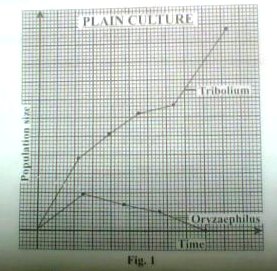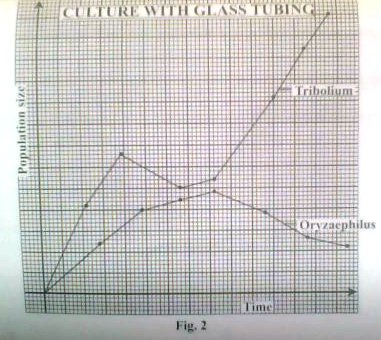1. a) Giving examples, explain the effect of:
i) increased selection pressure on a population
ii) stabilizing selection pressure on a population
b) Explain how comparative anatomy supports the process of evolution
2. a) Describe structural characteristics of cells of meristematic tissues.
b) Distinguish between apical and lateral meristems
c) Describe structural adaptations of vascular tissues for support.
3. Figures 1 and show the results of experiments carried out on two species of flour beetle, Tribolium and Oryzaephilus, which were grown together in slightly different environments. In figure 1 Tribolium and Oryzaephilus were grown in plain flour culture while in figure 2 they were grown in a culture which had glass tubings. For each experiment four adult beetles of each species were introduced in the culture and the population size of each species was determined at regular intervals. Study the information and answer the questions that follow.
a) Compare the population growth during the time of the experiment for Tribolium and Oryzaephilus bettles in:
i) figure 1
ii) figure 2
b) Explain the population growth of the two species in:
i) figure 1
ii) figure 2
c) Suggest what is being demonstrated by the interaction of the two species in:
i) figure 1
ii)figure 2
d) From the interaction of the species in figures 1 and 2, explain the effects of interspecific competition.
e) Suggest what would happen if:
i) the experiment infigure 2 was continued for sometimw
ii) Oryzaephilus bettle was grown alone.
4. In Drosophilia, the gene for wing length and shape of the abdomen are sex linked. The gens for long wing and broad abdomen are dominant over those for vestigial wings and narrow abdomen.
a) Work out the phenotypes resulting from a cross between a vestigial winged and broad abdomen male and a homozygous long winged and narrow abdomen female fly in the
i) F1 generation
ii) F2 generation
b) A cross between a female from the F1 generation in (a) (i) with a vestigial winged and narrow abdomen male fly gave the following results;
Long winged, narrow abdomen flies = 35
Long winged, broad abdomen flies =17
Vestigial winged and narrow abdomen flies =36
Vestigial winged, broad abdomen flies = 18
Account for the phenotypes and their relative numbers in the cross.
c) Explain why Drosophilia are commonly used in genetic experiments.
5. a) Explain the factors that affect the rate of heart bear in mammals
b) Describe:
i) the initiation and control of heart beat in humans
ii) maintenance of blood flow in humans
6. a) What advantages do endotherms have over ectotherms?
b) Explain the body responses of endotherms to cold environmental conditions
c) Describe the role of the following in temperature regulation.
i) Thermoreceptors
ii)Hypothalamus


